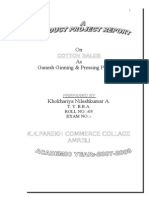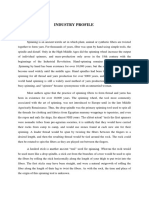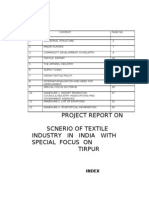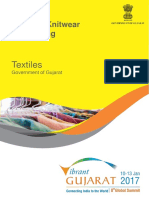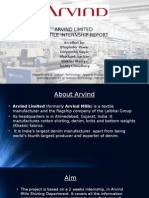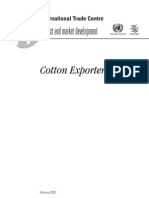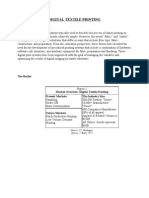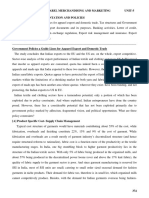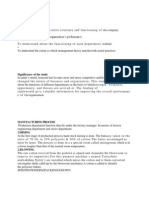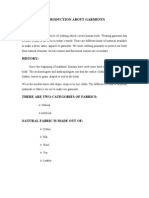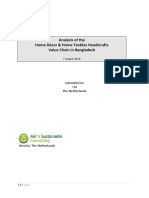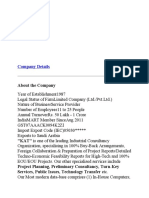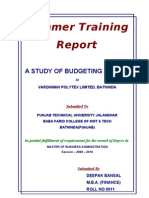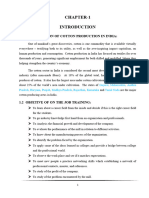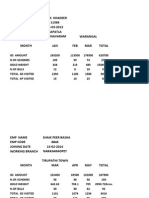0 ratings0% found this document useful (0 votes)
341 viewsCotton Industry
Cotton Industry
Uploaded by
Sakhamuri Ram'sThe document is a mini project report on the analysis of the textile industry, specifically focusing on cotton. It provides an introduction to the cotton industry and its history in India. It then discusses the major competitors in the industry and problems faced, including power shortages and low productivity. The report also profiles a specific company called Y.S.R. Spinning & Weaving Mills Pvt. Ltd, outlining its vision, products, competitors, policies, awards, and SWOT analysis.
Copyright:
© All Rights Reserved
Available Formats
Download as PPTX, PDF, TXT or read online from Scribd
Cotton Industry
Cotton Industry
Uploaded by
Sakhamuri Ram's0 ratings0% found this document useful (0 votes)
341 views18 pagesThe document is a mini project report on the analysis of the textile industry, specifically focusing on cotton. It provides an introduction to the cotton industry and its history in India. It then discusses the major competitors in the industry and problems faced, including power shortages and low productivity. The report also profiles a specific company called Y.S.R. Spinning & Weaving Mills Pvt. Ltd, outlining its vision, products, competitors, policies, awards, and SWOT analysis.
Original Description:
cotton industry ppt
Original Title
cotton industry
Copyright
© © All Rights Reserved
Available Formats
PPTX, PDF, TXT or read online from Scribd
Share this document
Did you find this document useful?
Is this content inappropriate?
The document is a mini project report on the analysis of the textile industry, specifically focusing on cotton. It provides an introduction to the cotton industry and its history in India. It then discusses the major competitors in the industry and problems faced, including power shortages and low productivity. The report also profiles a specific company called Y.S.R. Spinning & Weaving Mills Pvt. Ltd, outlining its vision, products, competitors, policies, awards, and SWOT analysis.
Copyright:
© All Rights Reserved
Available Formats
Download as PPTX, PDF, TXT or read online from Scribd
Download as pptx, pdf, or txt
0 ratings0% found this document useful (0 votes)
341 views18 pagesCotton Industry
Cotton Industry
Uploaded by
Sakhamuri Ram'sThe document is a mini project report on the analysis of the textile industry, specifically focusing on cotton. It provides an introduction to the cotton industry and its history in India. It then discusses the major competitors in the industry and problems faced, including power shortages and low productivity. The report also profiles a specific company called Y.S.R. Spinning & Weaving Mills Pvt. Ltd, outlining its vision, products, competitors, policies, awards, and SWOT analysis.
Copyright:
© All Rights Reserved
Available Formats
Download as PPTX, PDF, TXT or read online from Scribd
Download as pptx, pdf, or txt
You are on page 1of 18
At a glance
Powered by AI
The document discusses the cotton industry in India including its history, major competitors, problems faced, and policies of the government and companies.
The cotton industry in India has a rich history dating back to the 19th century when the British East India Company established major cotton production industries. Mechanization and modernization were gradually introduced.
Some major problems faced by the cotton textile industry include power shortages, low productivity of labor, industrial relations issues like strikes.
MINI PROJECT
A STUDY ON INDUSTRY AND COMPANY ANALYSIS
(WITH REFERENCE TO TEXTILE INDUSTRY)
A Mini Project report submitted in partial fulfillment of
the requirements for the completion of II Semester
Submitted by
G.SUMALATHA
(Reg. No. 13471E0082)
Under the guidance of
K.KRISHNA VENI
M.B.A,
Associate Professor
DEPARTMENTOF M.B.A.
NARASARAOPETA ENGINEERING COLLEGE,
NARASARAOPET-522601, GUNTUR (DT).
Affiliated to
Jawaharlal Nehru Technological University,
Kakinada
(2013 2015)
Introduction to cotton industry:
Cotton is a soft, staple fiber that grows around the seeds of the
cotton plant. It is a natural fiber harvested from the cotton plant. The
fiber most often is spun into yarn or thread and used to make a soft,
breathable textile, which is the most widely, used natural-fiber cloth in
clothing today.
History of cotton industry:
Indian Cotton Industry's history of establishment has a rich past.
English did gradual inaugurations of a number of beneficial
industries in India and the country was opening its eyes to a whole
new era of mechanisation. With 19th century India had
successfully established major production industries, owing to the
initiative of the British East India Company. Cotton was an
essential staple fabric, which was needed in almost every work of
life in India.
Major competitors in industry:
Company name place
1) Paramount Textiles Mills Pvt. Ltd - Madurai
2) Siva Sankari Mills - Coimbatore
3) PEC Ltd - Delhi
4) Indus Fila Pvt. Ltd - Bangalore
5) Alok Industries - Silvassa
6) R.M. Mohite Textilies - Kolhapur
7) Sachin Textiles - Ichalkaranji
8) Kayaar Exports - Tiruchengode.
9) GTN industries - Hyderabad
10) GTN Enterprises - Kochin
11) Prathibha Syntex - Ahmedabad
12) Mandhana Weaving House - Tarapur
13) Bombay Royan Fashions - Sangli
Problems in industry:
Cotton textile industry is obsessed with many problems. Two main factors
which have wrecked die industry are Government's textile policy and the
growth of the power loom sector.
Power shortage-Textile mills are facing acute shortage of power. Supplies of
coal are difficult to obtain and frequent cuts in electricity and load shedding
affect the industry badly. This leads to loss of man hours, low production and
loss in the mills.
Low productivity of labour-Low productivity is another major problem of cotton
textile industry. On an average an Indian factory worker only handles 380
spindles and 2 looms as compared to 1,500-2,000 spindles and 30 looms in
Japan. If the productivity of an American worker is taken as 100, the
corresponding figure for U.K. is 51 and for India only 13. Also industrial
relations are not very good in the country. Strikes, layoffs, retrenchments are
the common features of many cotton mills in the country.
POLICY OF GOVERNMENT OF INDIA TOWARDS SPINNING INDUSTRY
The Cotton production policies in India historically have been oriented toward
promoting and supporting the textile industry. The Government Of India
announces a minimum support price for each variety of seed cotton (kapas)
based on recommendations from the Commission for Agricultural Costs and
Prices. The Government Of India is also providing subsidies to the production
inputs of the cotton in the areas of fertilizer, power, etc
Markets for Indian Cotton
The three major groups in the cotton market are
Private traders
State-level cooperatives
The Cotton Corporation of India Limited.
SUGGESTIONS OF INDUSTRY
It is suggested that Government should provide good Infrastructure.
It is suggested that Government should provide loans.
It is suggested to maintain the inventory properly.
It is suggested to use the advanced technology to produce quality
output.
It is suggested to find the labour problems and solve them.
It is suggested to utilize the optimum resources.
It is suggested Modernization and consolidation for creating a global
competitive industry.
It is suggested to increase Indias share in world trade to 9%by 202
COMPANY PROFILE
Introduction:
Y.S.R. Spinning & Weaving Mills Pvt. Ltd was established in 1999,
with a spindle capacity of 4500 spindles. After expansion made in
2003 and 2006, it was having 25514 spindle and 1030 rotors and 8
numbers of air jet weaving machines to produce 5 tons of ring spun,
2 tons of open end, 1.5 tons of ring doubling and 2000 meters of
fabric per day.
In spinning department the mill has a complete range
of LMW, Trumac machines from blow room to spinning departments
and in weaving
Department PICANOL Omni plus air jet weaving machine.
VISION / MISSION
VISSION
The company has a vision to excel in all fields of textile industry and agriculture
produce basis.
The company will be intensively customer focused and will offer products and
services which provide the best value for the customers.
MISSION
To manufacture a high quality yarn thereby withstanding high level of
competitiveness.
Developing a long term relationship with the customers and suppliers.
To use latest technological strategies during production thereby forming an
innovative approach.
To provide a safe, fulfilling and rewarding work environment for the employees.
The company operates in the servicing and supporting the communities.
Promoters of the company:
Name of CEO
Mr. Y. Sridhar Reddy
Primary Business Type Manufacturer
Establishment Year 1999
No. of Employees 300
Market Cover
Annual Turnover Rs.70.00 Crores
Mr. Yerram Sridhar Reddy started his business as cotton
commission agent in 1977 at his native place Idupulapadu, Inkollu
Mandalam, Prakasam District, Andhra Pradesh,
ORGANIZATIONAL STRACTURE
Products:
PRODUCTS
The company offers an exclusive collection of white cotton fabrics of
all sizes. The white cotton fabric is made up of pure cotton. The company
also deals with the manufacturing and supplying of organic cotton yarn.
It provides organic cotton yarn in all shades. It uses environment
friendly procedure for producing our organic cotton yarn.
Cotton Fabrics cotton yarn.
Major competitors in company:
COMPETITORS
Y.S.R spinning mills is having 50 spinning mills as competetors.
Some of them are..
Dhanalakshmi cotton mills pvt Ltd., Ganapavaram.
ICM (Idupulapadu cotton mills), Ganapavaram.
Vasantha Spinning mills, Thimmapuram.
Tirumula spinning mills,Ganapavaram
Pujitha spinning mills,
Amaravathi textile mills,Martur
Prasuna vamsi Krishna spinning mills, Ganapavaram.
Siva Swathi textile pvt Ltd., Ganapavaram.
NSL textiles Pvt Ltd, Edlapadu.
POLICIES OF THE COMPANY
Quality Policy
Quality is integrals to everything at Y.S.R we adopt holistic quality
assurance system and an integrated system which covers the entire
production process. All lots are tested before giving to the mixing.
The company believes quality is a continual process. With a focus
clearly an delivering quality products and services, we integrate to constantly
innovate and excel.
Value
By a clear comprehension of the market dynamics and the assimilation
of the cutting edge technology the company assures the highest quality
standards are met at all times.
AWARDS OF THE COMPANY
Best exporter award from Government of A.P in 2005-2006.
Stood first in India in scientific processing of cotton Seed in 2007-2008
First in India domestic sales in cotton seed extraction in 2010-2011
SWOT ANALYSIS
Strength
YSR Spinning mill have rich resources of raw materials.
YSR Spinning mill is rich in highly trained manpower. The company have a
huge advantage due to lower wage rates.
It produces quality output.
Weakness
Labour force giving low productivity as compared to other competing
companies.
Technology obsolescence despite measures .
Low bargaining power in a customer-ruled market.
Company seriously lacks in trade pact memberships.
Opportunity
Low per-capita domestic consumption of textile indicating significant
Potential growth.
Companies need to concentrate on new product developments.
Increased use of CAD to develop designing capabilities and for developing
greater options.
Threats
Competition in post-2005 is not just in exports, but is also likely within the
country due to cheaper imports of goods of higher quality at lower costs.
Alternative competitive advantages would continue to be a barrier.
You might also like
- Grey Cloth Manufacturing ProcessDocument8 pagesGrey Cloth Manufacturing ProcessPriya JainNo ratings yet
- GRS Certified Units List 2017Document76 pagesGRS Certified Units List 2017GoBusiness-PlanNo ratings yet
- Customer Satisfaction Nagarjuna FertilizersDocument97 pagesCustomer Satisfaction Nagarjuna FertilizersSakhamuri Ram's100% (2)
- Past Year Q For Wireman 1Document18 pagesPast Year Q For Wireman 1陈系铭100% (1)
- DPWH IV-A Presentation For Engineering CongressDocument45 pagesDPWH IV-A Presentation For Engineering CongressApril Rose PlacerNo ratings yet
- Etihad RailDocument8 pagesEtihad RailMuhammad AbidNo ratings yet
- Flight Simulator X RewardsDocument20 pagesFlight Simulator X RewardsWingtipGlider0% (1)
- Cotton Mills of IndiaDocument16 pagesCotton Mills of IndiakaviyaNo ratings yet
- Cotton Bales PPRDocument30 pagesCotton Bales PPRKhunt DadhichiNo ratings yet
- A Project On The Spinning Industry of India: BY Deepak Luniya Roll No: 290Document45 pagesA Project On The Spinning Industry of India: BY Deepak Luniya Roll No: 290deepakluniyaNo ratings yet
- TextileDocument36 pagesTextileToday NewsNo ratings yet
- Priya - GarmentsDocument45 pagesPriya - GarmentsMukesh kannan MahiNo ratings yet
- Indian Textile Industry Chapter 1Document6 pagesIndian Textile Industry Chapter 1himanshuNo ratings yet
- Akshara Spinning MillsDocument42 pagesAkshara Spinning MillsbalaNo ratings yet
- Cotton Textile PDFDocument12 pagesCotton Textile PDFNeha MishraNo ratings yet
- Finished The Industry Profile in Spinning MillDocument11 pagesFinished The Industry Profile in Spinning MillMukesh kannan MahiNo ratings yet
- Technical Textiles With Application For DefenceDocument15 pagesTechnical Textiles With Application For DefenceMr.dhaliNo ratings yet
- 10 - Chapter 4 PDFDocument26 pages10 - Chapter 4 PDFAngu Ragul RajNo ratings yet
- Open End SpinningDocument8 pagesOpen End SpinningVikrant Kanugonda100% (2)
- Project ReportDocument79 pagesProject ReportRam Kumaran Ganeshan100% (1)
- Textiles: Hosiery/ Knitwear ProcessingDocument20 pagesTextiles: Hosiery/ Knitwear ProcessingShripadNo ratings yet
- Arvind Textile Internship Report-Final 2015Document50 pagesArvind Textile Internship Report-Final 2015Divyanshu Sagar0% (1)
- Cotton Exporters Guide TOCDocument26 pagesCotton Exporters Guide TOCAlvaro Elias BaquedanoNo ratings yet
- Economics ProjectDocument13 pagesEconomics ProjectvivekNo ratings yet
- Kenya S Apparel Amp Textile IndustryDocument27 pagesKenya S Apparel Amp Textile IndustryGladys WambuiNo ratings yet
- Textiles Sector - Achievement ReportDocument12 pagesTextiles Sector - Achievement ReportAnkitaNo ratings yet
- Zimbabwe Cotton VCADocument43 pagesZimbabwe Cotton VCAHavanyaniNo ratings yet
- Executive Summary Survey of Coir Industries in IndiaDocument27 pagesExecutive Summary Survey of Coir Industries in IndiaThayumaanShreeNo ratings yet
- Textile Industry - Colg Report - VardhmanDocument70 pagesTextile Industry - Colg Report - Vardhmanr_734100% (1)
- Case StudyDocument20 pagesCase Studyaj98No ratings yet
- Cotton Buyers Guide 2017Document25 pagesCotton Buyers Guide 2017Tuan Nguyen MinhNo ratings yet
- Shakthi Knitting LTD ProfileDocument5 pagesShakthi Knitting LTD Profileshakthiknitting100% (7)
- Indian Textile Overview and Swot AnalysisDocument20 pagesIndian Textile Overview and Swot AnalysisRenu Gupta100% (1)
- Natural CoirDocument19 pagesNatural CoirSelva Kumar100% (1)
- Research MethodologyDocument52 pagesResearch MethodologyBalakrishnan BalakrishnanNo ratings yet
- COTTON TEXTILE IndustryDocument24 pagesCOTTON TEXTILE IndustryMadhur MaheshwariNo ratings yet
- Current Scenario of Textile MachineryDocument19 pagesCurrent Scenario of Textile MachineryAnonymous aXFUF6No ratings yet
- Company ProfileDocument8 pagesCompany Profileananthakumar100% (1)
- Digital Textile PrintingDocument4 pagesDigital Textile Printingharoon76No ratings yet
- Cotton GinningDocument18 pagesCotton GinningRushlan KhanNo ratings yet
- Project Report On CottonDocument8 pagesProject Report On CottonManu ChawlaNo ratings yet
- Final+Report +++Raymond+Chhindwara1 1Document94 pagesFinal+Report +++Raymond+Chhindwara1 1Neeraj Kumar40% (5)
- Apparel Merchandising and MarketingDocument87 pagesApparel Merchandising and MarketingBhuva_jana100% (1)
- Problems Faced by Cotton Ginning Industries in PakistanDocument5 pagesProblems Faced by Cotton Ginning Industries in PakistanSahaab AkbarNo ratings yet
- Young-A Company ProfileDocument3 pagesYoung-A Company ProfileAhliDesainWebNo ratings yet
- Objectives of The StudyDocument47 pagesObjectives of The Study12boss100% (1)
- Internship ProjectDocument25 pagesInternship ProjectMithra SubramaniamNo ratings yet
- Cotton Variety ListDocument1 pageCotton Variety Listcottontrade100% (1)
- Introduction To Garment ManufactureDocument7 pagesIntroduction To Garment Manufacturedchidembaram941967No ratings yet
- Modern Ginning and Pressing UnitDocument8 pagesModern Ginning and Pressing UnitHiteshGondalia100% (3)
- Analysis of Price Fluctuation of Raw Cotton and Cotton YarnDocument116 pagesAnalysis of Price Fluctuation of Raw Cotton and Cotton Yarnjaysean28No ratings yet
- Textile Industry Internship ReportDocument137 pagesTextile Industry Internship ReportRaghul PrashanthNo ratings yet
- Home Textiles BangladeshDocument53 pagesHome Textiles BangladesharsumonNo ratings yet
- Silk Yarn PlantDocument21 pagesSilk Yarn PlantElnathan Samson100% (1)
- Fabric Manufacturing Mill Bangladesh TexDocument19 pagesFabric Manufacturing Mill Bangladesh TexRafiurRahmanNo ratings yet
- Factories Profile - Liberty Knitwear LimitedDocument1 pageFactories Profile - Liberty Knitwear Limitedshakib nazmusNo ratings yet
- Absorbent Cotton Manufacturing Machine CatalagueDocument27 pagesAbsorbent Cotton Manufacturing Machine Catalaguesnsurgicare100% (3)
- SWOT Analysis of Hosiery Industry in IndiaDocument14 pagesSWOT Analysis of Hosiery Industry in IndiaKSH. DOLLY DEVI100% (1)
- Spinning Mill ProjectDocument10 pagesSpinning Mill ProjectAtoZdigital Service CenterNo ratings yet
- CottonDocument17 pagesCottonSakhamuri Ram's100% (1)
- MAP Report For MBADocument57 pagesMAP Report For MBAMaulik TankNo ratings yet
- Amaravathi 16 PointsdDocument16 pagesAmaravathi 16 PointsdSakhamuri Ram'sNo ratings yet
- KirtiDocument57 pagesKirtiChandni SachdevaNo ratings yet
- Report FormatDocument30 pagesReport FormatBavatharaniNo ratings yet
- Ojt ReportDocument33 pagesOjt Reportpandim6477No ratings yet
- Funds Flow Statement Tirumala MilkDocument101 pagesFunds Flow Statement Tirumala MilkSakhamuri Ram's100% (3)
- "Funds Flow Statement": Eswar College of EngineeringDocument8 pages"Funds Flow Statement": Eswar College of EngineeringSakhamuri Ram'sNo ratings yet
- Financial Reports of Devi Sea LTD: Profit & Loss Account For The Year Ended 31St March, 2009Document11 pagesFinancial Reports of Devi Sea LTD: Profit & Loss Account For The Year Ended 31St March, 2009Sakhamuri Ram'sNo ratings yet
- Funds Flow StatementDocument101 pagesFunds Flow StatementSakhamuri Ram'sNo ratings yet
- Ancient Greek: Agriculture Agriculture, Also Called Farming or Husbandry, Is The Cultivation ofDocument4 pagesAncient Greek: Agriculture Agriculture, Also Called Farming or Husbandry, Is The Cultivation ofSakhamuri Ram'sNo ratings yet
- CottonDocument17 pagesCottonSakhamuri Ram's100% (1)
- Ratio Analysis 1012Document74 pagesRatio Analysis 1012Sakhamuri Ram'sNo ratings yet
- List of The Tables: SL NO NO Title of The Table Page NoDocument9 pagesList of The Tables: SL NO NO Title of The Table Page NoSakhamuri Ram'sNo ratings yet
- Industry Indan Cotton Textile ProfileDocument30 pagesIndustry Indan Cotton Textile ProfileSakhamuri Ram'sNo ratings yet
- Performance AppraisalDocument85 pagesPerformance AppraisalSakhamuri Ram'sNo ratings yet
- Amaravathi 16 PointsdDocument16 pagesAmaravathi 16 PointsdSakhamuri Ram'sNo ratings yet
- Eswar College of Engineering: "Financial Statement Analysis"Document6 pagesEswar College of Engineering: "Financial Statement Analysis"Sakhamuri Ram'sNo ratings yet
- Industry Indan Cotton Textile ProfileDocument30 pagesIndustry Indan Cotton Textile ProfileSakhamuri Ram'sNo ratings yet
- Master of Business Administration: A Study On Ratio Analysis With Reference To Jocil LimitedDocument97 pagesMaster of Business Administration: A Study On Ratio Analysis With Reference To Jocil LimitedSakhamuri Ram'sNo ratings yet
- Emp Name Shaik Khadeer Emp Code 11366 Joining Date 16-03-2013 Working Branch Bapatla Gannavaram Warangal Month JAN FEB MAR TotalDocument2 pagesEmp Name Shaik Khadeer Emp Code 11366 Joining Date 16-03-2013 Working Branch Bapatla Gannavaram Warangal Month JAN FEB MAR TotalSakhamuri Ram'sNo ratings yet
- Organizational Chart Chart 3.1: Managing Director-Board of Directors Division Head (Director)Document1 pageOrganizational Chart Chart 3.1: Managing Director-Board of Directors Division Head (Director)Sakhamuri Ram'sNo ratings yet
- KCP Final Project - 2.1Document110 pagesKCP Final Project - 2.1Sakhamuri Ram'sNo ratings yet
- Training & Development TirumalaDocument103 pagesTraining & Development TirumalaSakhamuri Ram's0% (1)
- Financial Statement Sivaswathi TEXTILESDocument103 pagesFinancial Statement Sivaswathi TEXTILESSakhamuri Ram'sNo ratings yet
- Inventory Management SWATHIDocument96 pagesInventory Management SWATHISakhamuri Ram'sNo ratings yet
- A Study On Consumer PerceptionDocument4 pagesA Study On Consumer PerceptionSakhamuri Ram'sNo ratings yet
- Customer Satisfaction AmaravathiDocument84 pagesCustomer Satisfaction AmaravathiSakhamuri Ram'sNo ratings yet
- Customer Satisfaction AmaravathiDocument84 pagesCustomer Satisfaction AmaravathiSakhamuri Ram'sNo ratings yet
- Inventory Management PROJECTDocument47 pagesInventory Management PROJECTSakhamuri Ram'sNo ratings yet
- PDFDocument450 pagesPDFazis fauzan100% (1)
- Application Information: ControlsDocument2 pagesApplication Information: ControlsIEQ DalvaNo ratings yet
- (Buyer's Official Letterhead) : White Refined Cane Sugar Icumsa 45 - Fit For Human ConsumptionDocument3 pages(Buyer's Official Letterhead) : White Refined Cane Sugar Icumsa 45 - Fit For Human ConsumptionKayla WhiteNo ratings yet
- Inclusion Body Solubilization BufferDocument2 pagesInclusion Body Solubilization BufferRebecca PotterNo ratings yet
- ETHICS 2022 Ethics Is The Branch of Philosophy That Studies Morality or The Rightness or Wrongness of HumanDocument20 pagesETHICS 2022 Ethics Is The Branch of Philosophy That Studies Morality or The Rightness or Wrongness of HumanJustin LapasandaNo ratings yet
- Geotechnical Engineering-Ii: BSC Civil Engineering - 5 SemesterDocument22 pagesGeotechnical Engineering-Ii: BSC Civil Engineering - 5 SemesterSaid-Mansour MohamedNo ratings yet
- Module 20 Hook Activity Hormones Functions 1. Hormones of ThyroidDocument2 pagesModule 20 Hook Activity Hormones Functions 1. Hormones of ThyroidDuchess Juliane Jose MirambelNo ratings yet
- The Beginner's Guide To Intermittent Fasting - and The Fascinating Science Behind This Hip Biohacking ToolDocument18 pagesThe Beginner's Guide To Intermittent Fasting - and The Fascinating Science Behind This Hip Biohacking ToolWilson Gayo100% (1)
- Evaluasi Instalasi Pengolahan Air Minum Di PT Hanarida Tirta Birawa Unit Ipa 1 Dan Ipa 2Document7 pagesEvaluasi Instalasi Pengolahan Air Minum Di PT Hanarida Tirta Birawa Unit Ipa 1 Dan Ipa 2Chimory VantageNo ratings yet
- EE Lab 9Document6 pagesEE Lab 9Abdullah TahirNo ratings yet
- Hypertensive Retinopathy - Yanoff and DukerDocument13 pagesHypertensive Retinopathy - Yanoff and DukerriveliNo ratings yet
- A Kitchen in The Corner of The HouseDocument2 pagesA Kitchen in The Corner of The HousedanielrubarajNo ratings yet
- Mulliken Electronegativity 1934Document13 pagesMulliken Electronegativity 1934Juan Camilo MartínezNo ratings yet
- Application of Erikson Theory in ClassroomDocument7 pagesApplication of Erikson Theory in ClassroomMahaashwetaa KumaranNo ratings yet
- NDT - Tech 02 1Document8 pagesNDT - Tech 02 1mark_59No ratings yet
- Sheet 2Document6 pagesSheet 2Aliaa TarekNo ratings yet
- Endodontic Orthodontic Relationships A Review of Integrated Treatment PlanningDocument18 pagesEndodontic Orthodontic Relationships A Review of Integrated Treatment PlanningAlfonso SernaNo ratings yet
- Roof Manual ModeDocument6 pagesRoof Manual Modewilliam_scottNo ratings yet
- Considerations in The Optimisation of Bench Face Angle and Berm Width Geometries For Open Pit MinesDocument22 pagesConsiderations in The Optimisation of Bench Face Angle and Berm Width Geometries For Open Pit MinesPaula OliveiraNo ratings yet
- Baby NameDocument10 pagesBaby NameKachhadiya BhaveshNo ratings yet
- 7-8 КЛАССЫ ЗАДАНИЯ 20-21Document7 pages7-8 КЛАССЫ ЗАДАНИЯ 20-21СтротегNo ratings yet
- Shelf Life Extension of CheeseDocument18 pagesShelf Life Extension of Cheesenils2484100% (1)
- Stenflex - GR Sae1 2H21Document2 pagesStenflex - GR Sae1 2H21françois MNo ratings yet
- SBG Nuclear Reactions - Direct & CNR, Fission & Fusion, ReactorDocument53 pagesSBG Nuclear Reactions - Direct & CNR, Fission & Fusion, ReactorSowgata ChowdhuryNo ratings yet
- STM PCMDocument39 pagesSTM PCMAditya Krishna AkulaNo ratings yet
- Clean Beauty Simple and SafeDocument12 pagesClean Beauty Simple and SafeRada PjanovicNo ratings yet








